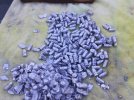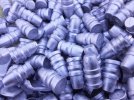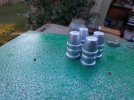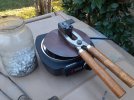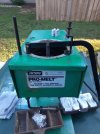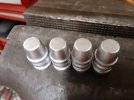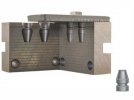I agree with Ian and Kevin. If it were my mould and my bullets came out like that (not all that bad), I'd do what Ian said - get the mould hotter and make bigger sprues. Scrub if you want - it can't hurt if you're not removing metal.
To quantify "bigger" sprues, somewhat, I strive to join all my multi-cavity moulds' sprues into one large one. They're easier to pick up that way too. When all the stars align, alloy temp, mould temp, intervals between pours, etc., you can form a pretty substantial sprue without having it run off the sides of the mould.
When I think about it, it's still hard to imagine it's happening - the cavity drawing from the sprue puddle, but it works, not just filling bases out, but corners too. Maybe metal isn't really running all the way from the sprue puddle to the corners of the mould's profile, but a big puddle is more mass, holding more heat longer, letting things fill out. My one bullet of that same basic shape is a 1C Ideal 429421, which gave me fits hen I first found it. I was ladle-casting at the time, and then bottom-pouring made it even more frustrating. I continued to ladle that one mould for quite a wile before it dawned on me to pour as big a sprue puddle on the sprue plate as I could and now I cast just fine with it.
I tried to weigh one of my 6C 22 cal sprues a couple weeks ago. This is SIX sprues joined together. It was WAY too much for my little 5-0-5 scale (tops out at 500 grains) to measure. I get either 300 or 330 grains' worth of bullets from each of two different 22 cal, 6C moulds, and the conjoined sprue weighs probably twice what the bullets do. I used to feel like remelting more than I got in bullets was inefficient, but rounded bases are a big no-go to begin with, because they are not consistently round and not necessarily concentric to the side of the bullet. Rounded corners on a 22 constitute a significant percentage of weight, and again, the form is going to be inconsistent. Well-formed 22 bullets shoot well. Those with an amorphous profile most assuredly won't. Not as big a deal as the diameter and volume of the bullet grows - or as the range lengthens.
Fair warning to a new member (and welcome here, by the way), that just because I type more than most everyone else when I post does not mean I am any (or at all) smarter than anyone else. I just take longer to say something - which you can and should test for yourself, because I have my own "superstitions" about casting which may or may not work - especially on a cursed of possessed mould, most of which, from my collection, I have exorcised of exiled by now. Two were actually drawn and quartered once (both Lees), and I may possibly have been mistaken about their actual guilt.
